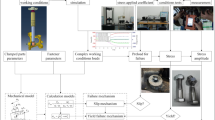Abstract
Due to the influences of isolation, Acontacts, Asliding, Afriction and other factors, the meshing process of screw thread is a nonlinear contact problem and its analysis is very complicated. Using the finite element method, we transform the nonlinear contact problems into nonlinear physical problems, establish the finite element model of screw thread connection structure by introducing the nonlinear gap element, and solve the model with the incremental method. We also investigate the finite element model of screw thread based on penalty function and verify the correctness of the gap element model. Through the analysis, the stresses and the deformations of screw thread under the axial load are obtained. Subjected to the condition of structural safety, we perform optimization designs of screw thread which obviously improve the load capacity of screw thread and reduce the stresses on the border. Our work provides a new way to the precise design of screw thread connection structure.
Access this chapter
Tax calculation will be finalised at checkout
Purchases are for personal use only
Preview
Unable to display preview. Download preview PDF.
Similar content being viewed by others
References
Zhiwei, Y., Xiaolei, X.: Failure analysis of connecting bolts and location pins assembled on the plate of main-shaft used in a locomotive turbochanger. Engineering Failure Analysis 15(5), 471–479 (2008)
Ching-Kong, C., Ching-Chi, H., Jaw-Lin, W., Jinn, L.: Increasing bending strength of tibial locking screws: Mechanical tests and finite element analyses. Clinical Biomechanics 22, 59–66 (2007)
Xiumin, C., Guangxian, S., Qingxue, H.: Rapping experiment of rolling mill pressure screw-pairs and plastic bulge of nut teeth analysis. Chinese Journal of Mechanical Engineering 43(4), 168–172 (2007)
Hou, S.M., Hsu, C.C., Wang, J.L., Chao, C.K., Lin, J.: Mechanical tests and finite element models for bone holding power of tibial locking screws. Clin. Biomech. 19, 738–745 (2004)
Hou, S.M., Wang, J.L., Lin, J.: Mechanical strength, fatigue life, and failure analysis of two prototypes and five conventional tibial locking screws. J. Orthop. Trauma. 16, 701–708 (2002)
Yunpeng, J., Yue, Z.: Stress distribution around the bolt hole in the bolt-loaded laminate. Journal of Mechanical Strength 28(2), 271–275 (2006)
Majzoobi, G.H., Farrahi, G.H., Habibi, N.: Experimental evaluation of the effect of thread pitch on fatigue life of bolts. International Journal of Fatigue 27(2), 189–196 (2005)
Dingning, Y., Jingxiang, Z.: Study on interference fit and separation process of flywheel for energy storage. Chinese Journal of Mechanical Engineering 39(4), 145–150 (2003)
Runfang, L., Jianxia, G.: The application of numerical methods to a contact analysis in mechanical design, pp. 17–20. Chongqing University Press (1991)
Heuze, F.E., Goodman, R.E., Bornstein, A.: Numerical analyses of deformability tests in jointed rock-‘joint perturbation’ and ‘no tension’ finite element solutions. Rock Mech. 3, 13–24 (1971)
Author information
Authors and Affiliations
Editor information
Editors and Affiliations
Rights and permissions
Copyright information
© 2009 Springer-Verlag Berlin Heidelberg
About this paper
Cite this paper
Zhu, Cc., Song, Cs., Lu, B., Luo, Jy., Luo, Zx. (2009). Analysis and Optimization of Contact Strength of Screw Thread. In: Cao, B., Li, TF., Zhang, CY. (eds) Fuzzy Information and Engineering Volume 2. Advances in Intelligent and Soft Computing, vol 62. Springer, Berlin, Heidelberg. https://doi.org/10.1007/978-3-642-03664-4_186
Download citation
DOI: https://doi.org/10.1007/978-3-642-03664-4_186
Publisher Name: Springer, Berlin, Heidelberg
Print ISBN: 978-3-642-03663-7
Online ISBN: 978-3-642-03664-4
eBook Packages: EngineeringEngineering (R0)




